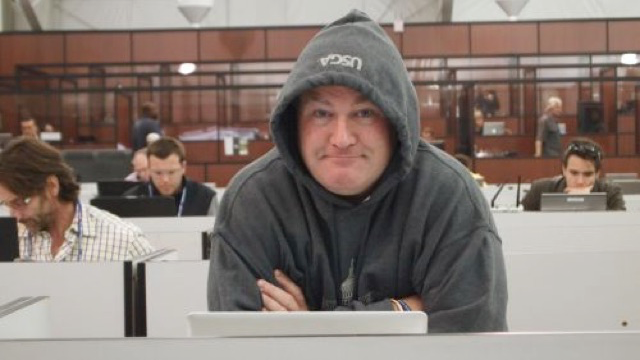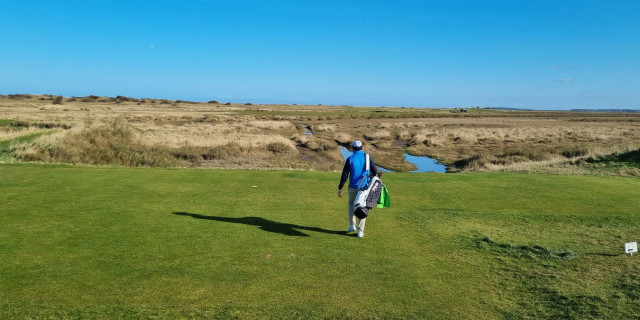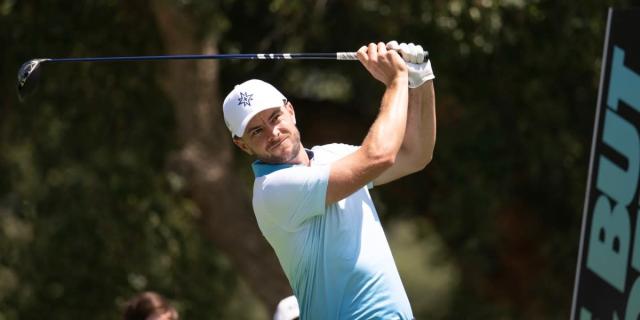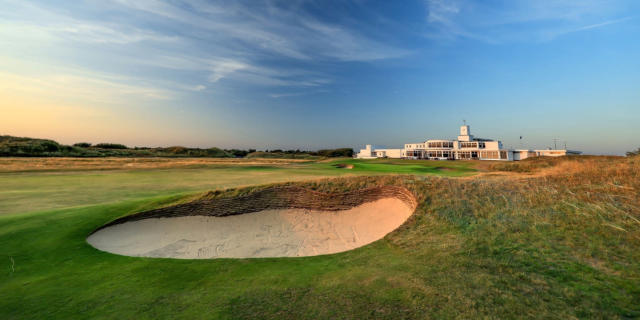
In conversation with John Huggan
Since receiving a job offer from Golf World Magazine in the spring of 1986, John Huggan has progressed from being one of Scotland’s finest amateur players into establishing himself as one of the game’s most important and knowledgeable writers. Spending eight years as the editor of instruction at Golf Digest, and subsequently almost two decades as a freelance journalist, the 55-year-old Scot’s consistently strong and persuasive columns have been printed in a number of publications throughout Europe, the United States, and even the southern hemisphere.
“It’s a novelty for me to be the story for once,” he says inside the media centre that has been erected adjacent to the Old Course at St. Andrews for the Alfred Dunhill Links Championship. John has been writing the stories and asking the questions for three decades.

When asked whether he remains in the dream job, the seasoned correspondent acknowledged. “I can’t imagine doing anything else. I still love golf. At its heart, I think there is no other game quite like it in terms of examining every aspect of someone’s ability and character.”
Having been introduced by his father, a young John Huggan began his relationship with the game almost half a century ago at Winterfield Golf Club in Dunbar. With its modest yardage and numerous par threes, the East Lothian course would prove to be the perfect setting for a developing golfer.
“I was also lucky enough to be around a group of young lads who were about the same age as me and were all keen. There were maybe about a dozen of us, and we played almost constantly in the summer. I remember often going round there four times in a day during the summer holidays.”
Playing within such a close-knit of friends was also an instigator to improve, with an early competitive edge being forged by the fact that many of the other boys were bigger and stronger.
“So I had to make up for it in other ways. I remember the great satisfaction in winning the Junior Championship there when I was actually beating them at last, after a long time of being beaten up.”
It was during this time that the long-suffering Hibernian supporter witnessed something that would forever define his perspective in golf. “I developed a taste for artistry rather than science in golf at a very early stage,” he says.
That was something best embodied during that era by the colourful American Lee Trevino, who a 13-year-old Huggan witnessed producing an exhibition of creativity and imagination on the practice range ahead of the 1973 Ryder Cup at Muirfield.
“There were only about 20 people there – of which my dad and I were two – and with Trevino it was just an absolute clinic of ball striking and shots. And the thing that has stuck with me the most, there was a little stick in the ground, about two feet high and maybe 90 or 100 yards away. And he goes ‘right folks, watch this’ and he gets a wedge out and just carved it miles away up in the air, and it came down a foot from the stick. And then, with the very next ball and same club, he knifed it along the ground deliberately and it stopped a foot from the stick. I’ve never forgotten that.”
Five years later, an ability to manufacture shots was required when winning the final of the Scottish Boys Championship in horrendous weather conditions at Dunbar.
“It was sideways rain, blowing a gale, and neither one of us could hold onto the club, we were just kind of bunting the ball forward,” he reflected on the match against Kevin Stables of Elgin. “It cleared up a bit in the afternoon, and it was a bit more sensible, but the first 18 holes of that final were just a nonsense if I’m honest.”
Representing Scotland at Boys, Youth and Full International level, Huggan balanced the demands of top-level amateur golf with working in a bank.
“This will show you the difference between full-time amateurs nowadays and leading amateurs back in the day.
“I played in the 1981 European Team Championship for Scotland, here in St. Andrews. We had lost in the final on the Sunday – had a big party on the Sunday night – and I got up on the Monday morning at six-o’clock and drove to Ayton (in Berwickshire) to start work in the bank the following morning, and I don’t see many leading amateurs doing that now.”
Having been runner-up in the 1983 Scottish Amateur and a losing quarterfinalist in the 1985 Amateur Championship at Royal Dornoch, many observers of the time would have surely included Huggan as being a potential member of the Great Britain and Ireland team for the Walker Cup.
“I think that I was reasonably close,” he said reflecting on that possibility. “I would have never been one of the stars of the team, by any means, if I had made a Walker Cup team I would have been in the lower half of the ten. My timing was bad, having said that. Had they picked a team at the end of 1983, instead of at the beginning, I would have undoubtedly been on the team because if I wasn’t the best amateur in Scotland, I was in the top two or three that season.
“Timing is everything when it comes to the Walker Cup (with it being every two years), so it was a wee bit unfortunate in that respect, and by the time the ’85 one came about, I was a student and was playing a lot less competitive golf.”
Studying business at the University of Stirling – a curious choice of subject that remains a mystery to him – Huggan was more than three years into a degree programme when he decided to seek an alternative career route within the game of golf itself.
“I wrote maybe 40 letters to any golf related company that I could think of. Golf World Magazine came back and said ‘there was a job here, can you talk to us.’ So I went down to London, I think it was the February of ’86. And talked to the editor and deputy editor over lunch, and as I walked out I remember thinking to myself ‘if I don’t get that job I’m in real trouble’ because it was tailor-made for me at that time. So, I went away and the letter duly came and they offered me the job.”
Just a year after that break into the industry, an intriguing opportunity arose at Golf Digest in the United States through a temporary personnel swap, which came about as a result of both publications having been under the umbrella of the New York Times.
“I had about a week’s notice that I was going to be shipped across to Connecticut for two months, to work at Golf Digest in the summer of ’87. And I can honestly say that I never gave a second’s thought to the idea that I might have a job possibility over there, but I had a great time in my two months.”
To his great surprise, those two months would eventually extend to eight years. Later that year, when in Paris to pursue a story for Golf World, John received an unexpected phone call from Jerry Tarde – who was and remains the editor of Golf Digest – offering him the job of essentially being the instruction editor of the magazine.
Living full-time in Connecticut, the youthful journalist worked closely with revered coaches such as David Leadbetter, Hank Haney and Peter Kostis, ghost-writing their pieces and gaining valuable experience, even if the loyal readers didn’t necessarily see an improvement in their own games.
“I always say that when I arrived at Golf Digest, the average handicap of the readership was 17.8, and when I left eight years later it was 17.8. So, I’m not sure how much of an influence I had. It’s very difficult to learn golf through the pages of a magazine.”
With Lee Trevino being a childhood favourite, it is little surprise that Huggan held the swashbuckling talents of the late Seve Ballesteros in the same esteem. Rating the experience of a one-to-one interview with the legendary Spaniard as being a career highlight, he reflected on spending time with the five-time major champion in his home village.
“I’ve interviewed pretty much all of the top players of the last 30 years or so, and the only time I’ve ever been intimidated was with Seve. I remember sitting in the clubhouse at Pedreña – where he was a member – and there was a big room, with windows looking out across the first tee. And we were sitting in a corner, just the two of us, and there was nobody else there in this massive room, and were going back and forth, and I glanced down at my notes to look at the next question, I glanced back up and there he was just kind of staring at me. And I remember thinking – gulping – that this is Seve Ballesteros.
“That’s the only time I’ve ever been a little bit taken aback by the stardom if you like.”
One significant development that has occurred during Huggan’s career as a journalist has been the progressive distancing of the leading players from members of the media, with those who ask the questions having never been more removed from the individuals that they’re covering.
“It is getting harder. Just getting time with them is more and more difficult, because they’re separated more and more from the likes of us (journalists) by the money that they’re making. I mean, just this week, I was asked by Golf World in this country to see if I could get time with a PGA Tour player, who, ah, let’s just call him David Lingmerth for the sake of argument, who is a Swedish lad, and we were interested in what his plans were in terms of Ryder Cup, and nobody really knows much about him.
“So, I went through his agent, which is nearly always a mistake. The agent came back and said ‘oh he’s very busy, and there’s three courses and as you know the golf has to be the number one priority’, and I did actually start to laugh out loud when I read that email. So, needless to say, the world will have to remain largely ignorant to what David Lingmerth is about.”
Anyone who has been a regular follower of John’s work in recent years will be more than aware of his immense frustration and growing despondency with the continuing advancement of golf equipment and the ball, which has largely gone unchecked by the governing bodies.
“I think it’s been damaging in the sense that – with the possible exception of Bubba Watson, nobody plays golf at the top level anymore like Seve Ballesteros or Lee Trevino. My two favourites. That just doesn’t happen, it seems to be more a test of execution, and the ability to hit the same shot over and over again has become more important than the ability to play ten different shots.”
With golf at the highest level becoming increasingly one-dimensional, there is more than a sense that viewers – and even players – are being short-changed by the less dynamic modern game.
“Oh, absolutely. I’ve talked with many of the top players, and they’re bored to tears with the game that they’re asked to play,” he continues. “And it doesn’t allow the very best ones to separate themselves from everyone else as easily as they should.
“What Tiger Woods achieved at the time he did was remarkable, obviously, but was even more remarkable given the equipment the way that the ball was going. Everything was designed to bring the rest closer to him, the best, whereas he should have been able to separate himself further. He should have been winning by more, I mean, the fact that he won as often as he did and by as many as he did might be the single greatest feat in the history of the game.”
Having been fortunate enough to be inside media centres and around the action during that electrifying period of dominance around the turn of the century, John was a first-hand witness of that history etched by Tiger, with one particular week standing out.
“I go back to Pebble Beach in 2000, I was there at the U.S. Open. That’s the best golf I’ve ever seen. And I think that might be the best golf that anyone has ever played. To win a U.S. Open by 15 shots, to be the only guy under-par. Jack Nicklaus is still the best golfer, scorer that we’ve ever seen. But I think the best golf we’ve ever seen has been played by Tiger Woods.”
Starting his journalistic career during an era when Seve, Nick Faldo and Greg Norman were at the top, John’s tenure has seen more than two generations of champions. But despite admitting to being increasingly jaded and cynical, he is still drawn in by the three players who are currently jostling at the summit of the men’s game.
“I do like to watch all three of them, for different reasons. I think Rory (McIlroy) is the most naturally gifted. His best golf is still the best of the three. If they all played their best in a tournament, Rory would win. I still think that. Jason Day is a terrific talent, he might be a better all-round player day-to-day than Rory, and (Jordan) Spieth brings a bunch of intangibles to the game. He doesn’t hit the ball as far as Day or McIlroy, but he putts so much better and he scores better.”
With the gifts of these talented players being enhanced by the modern equipment and golf ball, historic courses have been pushed to their absolute limits. Setups for major championships have become ever more restrictive, tightening the fairways and growing the rough, not in an effort to make the tournament more interesting, but in an attempt to rein in the scoring. It has often been said that if a course doesn’t yield a low score to great play, then there is something wrong with it.
“That’s absolutely right. I’ve written that many times. The perfect example of that goes back to Oakmont (in 2007) when (Angel) Cabrera won (the U.S. Open). I think it was the second round, where Tiger Woods was at the very top of his game and shot 69. Now, Tiger Woods (only) shot 69 at the top of his game, there’s something wrong with the golf course. There really is. And the great tragedy of that course is that I think that could be the best in the world if they eliminated the rough completely.
“It would be the most interesting, fascinating, and demanding test. It wouldn’t be easy. You would be able to create your own angles for second shots. This dictation of making everybody play the hole the same way, which is what the USGA seem to love most of the time, is lost on me.”
With a recent change of leadership at the R&A, there is perhaps renewed – if faint – hope that something could be done to address the monstrous distance that the ball now travels. Jack Nicklaus and Arnold Palmer would certainly welcome that effort, as would John Huggan.
“When you speak privately to these guys (at the R&A), they’ll all admit that there’s a problem with the game in that it’s not nearly as interesting to watch and play at the top level as it used to be. So I would hope that there is a will to do something, whether there is the ability to do it is a different matter.
“I would say that they should just do it and ask the public to support them in this. Say to the public that we’re doing this because the game has lost its way and something needs to do be done, and we can make the game better if you can bear with us on this. Convince them of your argument, but the thing is they’ve stopped even making the argument. The case is not being made.”
In addition to Martin Slumbers succeeding Peter Dawson at the R&A, Keith Pelley has recently become the Chief Executive of the European Tour. With the gargantuan purses on the PGA Tour continuing to dwarf over the comparatively paltry coffers on this side of the Atlantic, there are challenges for the new man in ensuring that the circuit remains relevant in the future.
“He’s got to do something about the money, if he wants the top players to come and play. It’s just a fact of life. They’re professionals for a reason. But I don’t think he has to match the PGA Tour, I think he has to get reasonably close. That would be the difference. I’ve heard a number of leading players, not Americans, obviously, who’ve all said to me that they would much rather play in Europe. They would have a lot more fun, and it would be a lot more interesting and enjoyable for them.
“But the money difference is so vast that it doesn’t make any sense for them to do that. I think if he got within 10% with the prize money that might just be enough to persuade a good number of the top European, Australasian and South African players to come and play in Europe certainly more of the time than they do right now.”
That path to growth for the European Tour may ultimately come through an increased and targeted collaboration with international tours, focusing on building a schedule of strong events during weaker periods on the PGA Tour calendar.
“There should be an all-World-Tour except the U.S. That’s the only way that they’re ever going to be able to take on the PGA Tour. For example, I certainly think that the European Tour should be in bed with the Asian Tour, and bring Australasia in there. They should be in Australia and New Zealand for the month of February every year. That month, for me, is totally up for grabs at the moment.”
Listening to John Huggan talk about golf is to hear someone with an absolute command of their subject, and possessing the ability to express that knowledge in an articulate and engaging manner. He has a considered response for each topic. The hour has flown by. It is clear that he would be excellent on television, but perhaps not best suited to the apparent restrictions of that medium.
“Broadcasters tend to be more in business with the people that they’re covering, than the journalist does. I’ve never quite understood why Sky (Sports), as an example, their football coverage I think is terrific, with their pundits seemingly able to say whatever they want in terms of critical comment. But that is not replicated in the golf. There seems to be an invisible line that cannot be crossed.
“I know a lot of the people who work for Sky well, and I know how much they know about golf, and they don’t get the chance, or they don’t have permission if you like to show that expertise as much as they should. And that’s frustrating for me.”
More disappointing for John, however, has been the contraction in the print media during the past decade, with a significant decline in newspapers and magazines resulting in a disproportionate reduction in golf coverage. Startlingly, the Daily Telegraph and Daily Mail are now the only two newspapers in the United Kingdom that have retained a full-time golf correspondent.
“I’m a perfect example, I’ve been freelance for almost 20 years. And I’ve taken two pretty major hits to my income level in the last 18 months, with the weekly Golf World in America becoming a digital product and much smaller than it used to be, and just recently my column in the Scotland on Sunday, which I’ve done for 16 years, is going to disappear in a couple of weeks because of cuts at the Scotsman and Johnston Press.
“And I’m just an example of what’s happening, because actually there are guys who have disappeared completely.”
There is more than a depressing eeriness to the sparsely populated media centre at St. Andrews, which is a sight that is becoming more common. The game is losing voices, particularly critical ones, with strong journalism within the game unfortunately now becoming largely a thing of the past.
“The way we’re headed – the end game is that for example the only people in five years’ time writing about the PGA Tour will be PGA Tour.Com. Now, with the best will in the world, we can’t expect too much critical comment from that. More and more, we have to compromise. You don’t get the hard-hitting pieces that you used to get because people are trying to stay in the game. It’s definitely not what it was.”
Having spent significant time with many of the past giants of the profession, John has carried on that legacy of strong, persuasive sports journalism with his own work, which makes his voice so critically important for those of us who covet more than articles that are merely promotional extensions for the tours.
“I can remember feeling like the luckiest man in the world when I first went to Golf Digest in the States, and we would go to the Masters. And we always rented a big house for people to stay in, and in the evenings, I would be sitting in the corner of a big table, and it would be Dan Jenkins, Frank Hannigan, Dave Anderson from the New York Times, and even the late Dave Marr, who was a great raconteur and a lovely man. I still miss him. He would come round – and Tom Callaghan would be there – and they would compete with each other to tell stories.
“And I wish I taped it all, it was just the most fascinating thing.”
Though he rarely plays anymore, with a lack of time and general apathy inhibiting his ability and desire to strike balata with persimmon, John’s passion for the game remains tangible, as does his talent for pointing out its obvious absurdities and flaws.
“I hate to pick on America, but Pine Valley, which is routinely voted number one on every best course in the world list, you can’t go in or walk around and have a look at the place, never mind play. It’s surrounded by a big fence. I think that’s just appalling.
“And it’s not just America, I’ve been lucky enough to play quite a lot of golf at Muirfield with a friend of mine who used to be the greenkeeper there, we’d go out in the evening and play after he finished work. Sometimes, on a beautiful summer’s night, we were the only two people on the golf course. That’s great for us, but there is something wrong with that. Why has the game gone in that direction? It’s supposed to be an inclusive game, not an exclusive game at its best. And I think in many ways, that’s why it has such a terrible image with non-golfers.”
Those socially elitist conventions are maddening, and it is highly regrettable that the top level of the game no longer has a place for the creative talents of a Seve Ballesteros or Lee Trevino.
Golf has lost its way and become fractured in so many aspects, and that is why the likes of John Huggan are required now more than ever before to observe the faults and make those arguments. Losing his voice would be the gravest madness of all.
Image Credit: Golf, by TourMiss (www.golfbytourmiss.com)
About the author

Kieran Clark is the Digital Editor of Golfshake. He oversees editorial content, community engagement, forums, and social media channels. A lifelong golfer from the Isle of Bute in Scotland who has now lived in St Andrews for a decade, he began playing at the age of five and maintains a passion for exploring courses, with a particular affection for historic layouts. Kieran regularly contributes in-depth opinion pieces and features, drawing on his enthusiasm for the game and its culture.
Tags: interview









